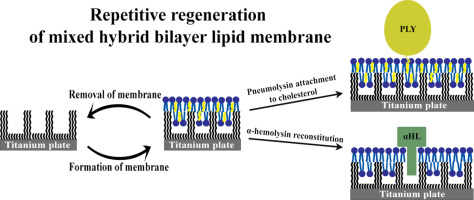当前位置:
X-MOL 学术
›
BBA Biomembr.
›
论文详情
Our official English website, www.x-mol.net, welcomes your feedback! (Note: you will need to create a separate account there.)
Mixed hybrid bilayer lipid membranes on mechanically polished titanium surface.
Biochimica et Biophysica Acta (BBA) - Biomembranes ( IF 3.4 ) Pub Date : 2020-02-28 , DOI: 10.1016/j.bbamem.2020.183232 Tomas Sabirovas 1 , Aušra Valiūnienė 1 , Inga Gabriunaite 1 , Gintaras Valincius 2
Biochimica et Biophysica Acta (BBA) - Biomembranes ( IF 3.4 ) Pub Date : 2020-02-28 , DOI: 10.1016/j.bbamem.2020.183232 Tomas Sabirovas 1 , Aušra Valiūnienė 1 , Inga Gabriunaite 1 , Gintaras Valincius 2
Affiliation

|
Mixed self-assembled monolayers of octadecyltrichlorosilane (OTS) and methyltrichlorosilane (MTS) were deposited via simple silanization procedure on a mechanically polished titanium surface. The monolayers act as molecular anchors for hybrid bilayer lipid membranes (mhBLM) which were accomplished via vesicle fusion. A variation of the MTS concentration in silanization solutions significantly affects properties of mhBLMs composed of a 1,2-dioleoyl-sn-glycero-3-phosphocholine (DOPC) and cholesterol (Chol). The bilayers become less insulating following an increase of the MTS content. On the other hand, an increase of the MTS concentration provides flexibility of the mhBLM membranes necessary for functional reconstitution of membrane proteins. The optimal molar ratio of MTS in silanization solution is 40% providing anchors for intact mhBLMs as confirmed by their specific capacitance of 0.86 μF cm-2. We found that the bilayers containing 40% (mol) of cholesterol bind cholesterol dependent pneumolysin (PLY). However, we did not observe functional reconstitution of PLY. While α-hemolysin almost fully disrupts mhBLMs assembled from 100% diphytanoyl. An important advantage of the titanium/OTS/MTS molecular anchor systems is their ability of repetitive regeneration of phospholipid bilayers without losing functional properties as demonstrated in the current study. This creates possibility for the multiple-use phospholipid membrane biosensors which have a potential of decreasing cost of such electrochemical/electroanalytical devices.
中文翻译:

机械抛光的钛表面上的混合混合双层脂质膜。
十八烷基三氯硅烷(OTS)和甲基三氯硅烷(MTS)的混合自组装单层膜通过简单的硅烷化程序沉积在机械抛光的钛表面上。单层充当通过囊泡融合实现的混合双层脂质膜(mhBLM)的分子锚。硅烷化溶液中MTS浓度的变化会显着影响由1,2-二油酰基-sn-甘油-3-磷酸胆碱(DOPC)和胆固醇(Chol)组成的mhBLM的性能。随着MTS含量的增加,双层的绝缘性降低。另一方面,MTS浓度的增加为膜蛋白的功能重建提供了必要的mhBLM膜的灵活性。硅烷化溶液中MTS的最佳摩尔比为40%,这为完整的mhBLM提供了锚定点,其比电容为0.86μFcm-2证实了这一点。我们发现包含40%(mol)胆固醇的双层结合了胆固醇依赖性肺炎球菌溶血素(PLY)。但是,我们没有观察到PLY的功能重建。虽然α-溶血素几乎完全破坏了由100%双植烷酰基组装而成的mhBLM。钛/ OTS / MTS分子锚固系统的一个重要优点是它们能够重复再生磷脂双层,而不会失去本研究中显示的功能特性。这为具有多种用途的磷脂膜生物传感器创造了可能性,所述生物传感器具有降低这种电化学/电分析装置的成本的潜力。我们发现包含40%(mol)胆固醇的双层结合了胆固醇依赖性肺炎球菌溶血素(PLY)。但是,我们没有观察到PLY的功能重建。虽然α-溶血素几乎完全破坏了由100%双植烷酰基组装而成的mhBLM。钛/ OTS / MTS分子锚固系统的一个重要优点是它们能够重复再生磷脂双层,而不会失去本研究中显示的功能特性。这为具有多种用途的磷脂膜生物传感器创造了可能性,所述生物传感器具有降低这种电化学/电分析装置的成本的潜力。我们发现包含40%(mol)胆固醇的双层结合了胆固醇依赖性肺炎球菌溶血素(PLY)。但是,我们没有观察到PLY的功能重建。虽然α-溶血素几乎完全破坏了由100%双植烷酰基组装而成的mhBLM。钛/ OTS / MTS分子锚固系统的一个重要优点是它们能够重复再生磷脂双层,而不会失去本研究中显示的功能特性。这为具有多种用途的磷脂膜生物传感器创造了可能性,所述生物传感器具有降低这种电化学/电分析装置的成本的潜力。虽然α-溶血素几乎完全破坏了由100%双植烷酰基组装而成的mhBLM。钛/ OTS / MTS分子锚固系统的一个重要优点是它们能够重复再生磷脂双层,而不会失去本研究中显示的功能特性。这为具有多种用途的磷脂膜生物传感器创造了可能性,所述生物传感器具有降低这种电化学/电分析装置的成本的潜力。虽然α-溶血素几乎完全破坏了由100%双植烷酰基组装而成的mhBLM。钛/ OTS / MTS分子锚固系统的一个重要优点是它们能够重复再生磷脂双层,而不会失去本研究中显示的功能特性。这为具有多种用途的磷脂膜生物传感器创造了可能性,所述生物传感器具有降低这种电化学/电分析装置的成本的潜力。
更新日期:2020-03-02
中文翻译:

机械抛光的钛表面上的混合混合双层脂质膜。
十八烷基三氯硅烷(OTS)和甲基三氯硅烷(MTS)的混合自组装单层膜通过简单的硅烷化程序沉积在机械抛光的钛表面上。单层充当通过囊泡融合实现的混合双层脂质膜(mhBLM)的分子锚。硅烷化溶液中MTS浓度的变化会显着影响由1,2-二油酰基-sn-甘油-3-磷酸胆碱(DOPC)和胆固醇(Chol)组成的mhBLM的性能。随着MTS含量的增加,双层的绝缘性降低。另一方面,MTS浓度的增加为膜蛋白的功能重建提供了必要的mhBLM膜的灵活性。硅烷化溶液中MTS的最佳摩尔比为40%,这为完整的mhBLM提供了锚定点,其比电容为0.86μFcm-2证实了这一点。我们发现包含40%(mol)胆固醇的双层结合了胆固醇依赖性肺炎球菌溶血素(PLY)。但是,我们没有观察到PLY的功能重建。虽然α-溶血素几乎完全破坏了由100%双植烷酰基组装而成的mhBLM。钛/ OTS / MTS分子锚固系统的一个重要优点是它们能够重复再生磷脂双层,而不会失去本研究中显示的功能特性。这为具有多种用途的磷脂膜生物传感器创造了可能性,所述生物传感器具有降低这种电化学/电分析装置的成本的潜力。我们发现包含40%(mol)胆固醇的双层结合了胆固醇依赖性肺炎球菌溶血素(PLY)。但是,我们没有观察到PLY的功能重建。虽然α-溶血素几乎完全破坏了由100%双植烷酰基组装而成的mhBLM。钛/ OTS / MTS分子锚固系统的一个重要优点是它们能够重复再生磷脂双层,而不会失去本研究中显示的功能特性。这为具有多种用途的磷脂膜生物传感器创造了可能性,所述生物传感器具有降低这种电化学/电分析装置的成本的潜力。我们发现包含40%(mol)胆固醇的双层结合了胆固醇依赖性肺炎球菌溶血素(PLY)。但是,我们没有观察到PLY的功能重建。虽然α-溶血素几乎完全破坏了由100%双植烷酰基组装而成的mhBLM。钛/ OTS / MTS分子锚固系统的一个重要优点是它们能够重复再生磷脂双层,而不会失去本研究中显示的功能特性。这为具有多种用途的磷脂膜生物传感器创造了可能性,所述生物传感器具有降低这种电化学/电分析装置的成本的潜力。虽然α-溶血素几乎完全破坏了由100%双植烷酰基组装而成的mhBLM。钛/ OTS / MTS分子锚固系统的一个重要优点是它们能够重复再生磷脂双层,而不会失去本研究中显示的功能特性。这为具有多种用途的磷脂膜生物传感器创造了可能性,所述生物传感器具有降低这种电化学/电分析装置的成本的潜力。虽然α-溶血素几乎完全破坏了由100%双植烷酰基组装而成的mhBLM。钛/ OTS / MTS分子锚固系统的一个重要优点是它们能够重复再生磷脂双层,而不会失去本研究中显示的功能特性。这为具有多种用途的磷脂膜生物传感器创造了可能性,所述生物传感器具有降低这种电化学/电分析装置的成本的潜力。


























 京公网安备 11010802027423号
京公网安备 11010802027423号